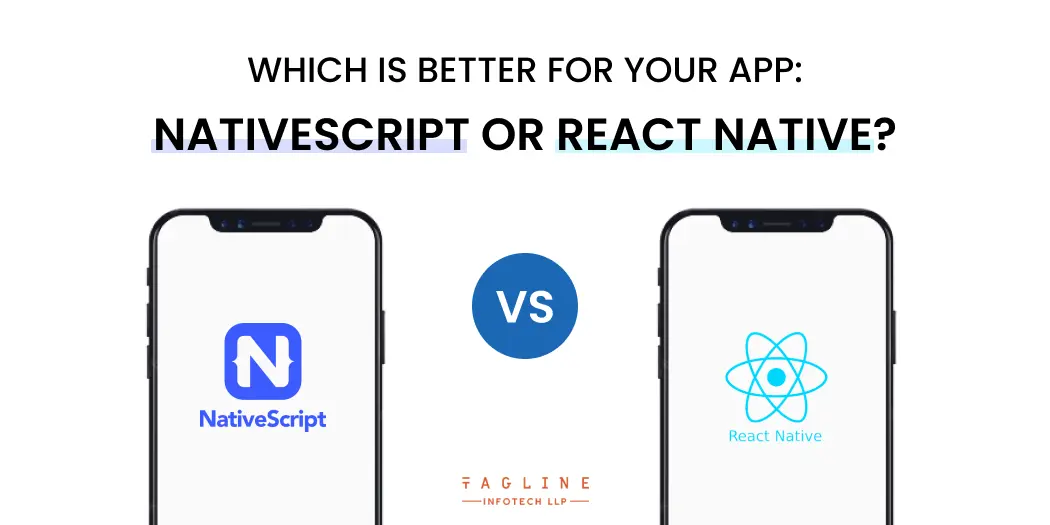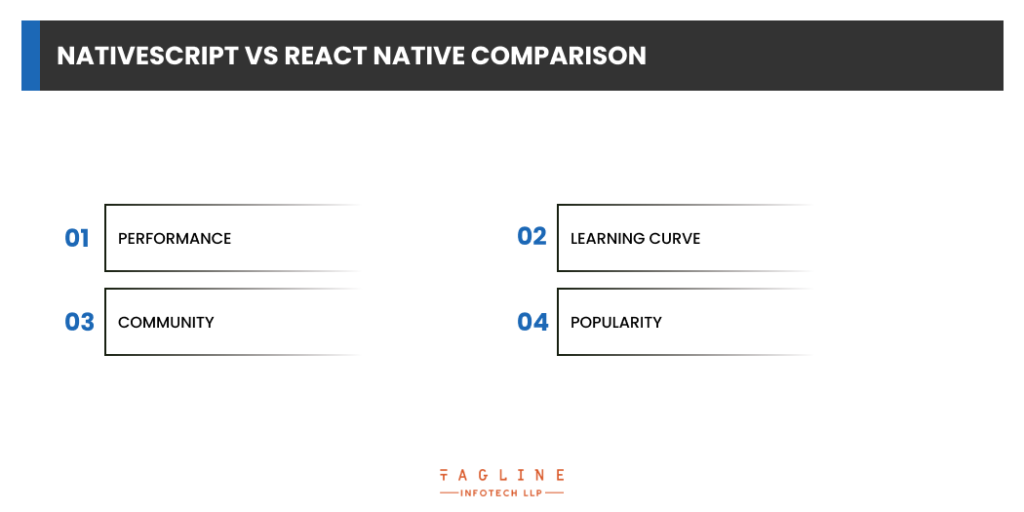A List of The 25 Best Ruby on...
May 8, 2024
Home >> React Native >> NativeScript vs. React Native: Comprehensive App Development

The idea of creating an application specifically for a business is undoubtedly a great one for entrepreneurs. However, there are a number of actions and choices that business owners must take before creating an application. The choice between native applications and hybrid apps has always existed when it comes to app development. We have compared React Native to NativeScript in order to uncover all the pertinent information you should be aware of.
Knowing the distinction between Native and hybrid apps is the first and most important step in determining what sort of app will assist your business achieve success in this era of applications that are pervasive on the internet and where digital marketing is the best form of advertising.
The following step is to compare Nativescript with React Native to determine which framework is the best for creating native apps. Therefore, before moving on to creating applications, we have created this guide that briefly outlines the fundamentals of hybrid and native apps.
Let’s quickly go over how the two frameworks function before we begin to disassemble them. First off, it is not a magical process. You write your programme, and either React Native or NativeScript translates (or rather, compiles) the codebase into native UI components at runtime. Behind the scenes, the JavaScript calls in each of the tools are translated to the corresponding native UI elements on a specific mobile device.
So, for instance, text rendering on iOS and Android is understood as [UIView] and [TextView], respectively. However, it’s crucial to keep in mind that neither React Native nor NativeScript generate code in a native app language, such as Kotlin for Android or Objective-C for iOS.

It’s not easy to pick one framework between two JS-based frameworks. Both offer benefits that are relatively similar due to being cross-platform. However, React Native truly shines in particular industries. The performance, learning curve, popularity, and development community of the two frameworks, as well as other important characteristics, are briefly compared below.
An open-source framework called NativeScript is used to create native mobile applications for iOS and Android devices. As a general rule, it uses JavaScript and CSS to render the UIs and offer a native-like experience. Users are typically drawn to NativeScript by its customised tech stack. JavaScript or TypeScript (essentially any language related to JavaScript) is used to build NativeScript. React vs. Angular is one of the frameworks that NativeScript supports. In 2017, Progress Software EAD (formerly Telerik) assisted and supported the emergence of this framework. There are currently 166 contributors to it on GitHub.
Additionally, wrappers are not necessary when using NativeScript to repurpose third-party libraries from Maven, CocoaPods, and npm.js.
React Native is an open-source, free framework that can be used to create cross-platform applications. Technically speaking, React Native uses the React library as its component source and JavaScript as its primary language of development. React Native had a brilliant impact on the mobile developer market back in 2015. Facebook’s introduction of React Native for iOS was the first success. Secondly, in September, the Android version became accessible via GitHub.
Want to build a React Native app that breaks down barriers and connects with all users?
Hire React Native developer who has a deep understanding of accessibility principles and can implement them flawlessly.
React Native, which focuses on the community, has more than 2083 contributors and is also supported by Facebook. React Native is typically an open-source JavaScript framework developed by Facebook. Developers may create native mobile applications for the iOS and Android platforms using React Native.
Both frameworks offer native app performance to start. Both take a long time to load. But this is where React Native takes the stage.
NativeScript renders pages slowly. To be really honest, delayed rendering is unacceptable in a society where every second matters. This is the very situation when React Native is useful. React Native uses native SDKs to render apps while rendering dynamic elements. It’s all because of the Virtual DOM. React Native becomes a very fast framework thanks to DOM.
First distinction: React Native leans more towards native performance than NativeScript.
Difference 2: React Native renders the user interface more quickly than NativeScript because it makes use of the Virtual DOM.
NativeScript and React Native cannot be handled by a developer with only JS skills. Let’s consider this. Initially, NativeScript will be simpler for developers with an Angular background. Programmers with a React background, on the other hand, will find the shift to React Native easier.
One thing to keep in mind is that JavaScript is used by both platforms. For front-end developers, this is a fantastic chance. At these times, it is somewhat simpler to perceive these frameworks. Choosing React Native means that all you need is JavaScript, whereas NativeScript provides assistance through its declarative coding approach.
Developers can use: both NativeScript and React Native to write:
Microsoft’s TypeScript, an open-source programming language with additional features that can be compared to JavaScript, and Facebook’s Flow, an open-source static type checking library that enables JavaScript code to incrementally add types.
However, you’ll see that React Native utilises Flow by default while NativeScript uses TypeScript if you create a new project in that framework. Of course, you’re free to modify that if you like.
React Native has a larger developer community than NativeScript, which is used by 11% of programmers, with 42% of programmers. React Native is also very popular since tech behemoths like Instagram and Tesla selected it over PhoneGap or NativeScript to create their applications.
The importance of considering community support is vital while deciding on the best structure. Even though it may seem odd, NativeScript has existed for a lot longer than React Native. React Native was published on March 26, 2015, whereas NativeScript was first made available in 2014. Although the one-year gap may appear to be an advantage, NativeScript is increasingly being replaced with React Native. React Native records 533k downloads on npm weekly, compared to under 7k downloads per week for NativeScript as of the publication date.
Speaking of contributors, React Native beats out NativeScript with more than 2200 contributors on GitHub. NativeScript has 208 contributors. On GitHub, React Native is really used by 720k developers, whereas NativeScript is used by greater than 3.5k. These margins show the developer community’s widespread acceptance of React Native, which has an effect on the amount of third-party libraries, replies, and bug solutions on StackOverflow. Overall, React Native triumphs in this case.
“React Native vs Swift: Which is best for iOS App Development?”
– Also Read Article
React Native has surpassed other comparable frameworks like Xamarin, Flutter, Ionic, or NativeScript to become the most widely used cross-platform mobile development framework. But popularity isn’t necessarily a reliable yardstick for comparison. And given that React Native was created by Facebook, its meteoric rise to popularity almost from the beginning is understandable.
Both NativeScript and React Native were developed using JavaScript. The competition is never far apart. According to a 2019 StackOverflow survey, JavaScript was the most widely used technology. React.js has surpassed Angular.js/Angular and Vue.js when it comes to web frameworks. It appears that developers favour React.js more.
React Native lacks a key feature that NativeScript possesses, namely an official marketplace with plugins that is constantly being updated and developed.
With React Native, you must rely on third-party libraries and plugins developed by its sizable contributor community. The drawback of this is that despite the abundance of repositories available, there is always a chance that those third-party repos will be abruptly shut down. If such occurs, developers are forced to either hunt for something with comparable functionality or make the necessary changes themselves, which might extend the time and expense of development.
We’ve already covered how easy it is for NativeScript and React Native to use JavaScript to access native Android and iOS APIs.
With NativeScript, all iOS and Android APIs may be accessed directly without the need for boilerplate wrappers. The NativeScript Marketplace offers a large variety of pre-made, open-source NativeScript plugins if you don’t want to write directly against the iOS and Android APIs.
The built-in components of React Native can be easily expanded by browsing the npm registry for packages that mention the framework. However, the framework lacks a dedicated marketplace for plugins. Developers can access the full capability of the target platform by writing genuine native code using native modules, although this is rarely necessary because React Native is so powerful out of the box.
When it comes to react native vs nativescript performance, React Native has a multi-threaded design, with JavaScript and the user interface operating on distinct threads, whereas NativeScript uses a single-threaded approach since it offers quick access to the native APIs. The fact that JavaScript processing does not obstruct UI rendering is the main benefit of React Native’s multi-threaded architecture.
On the other side, when processor-demanding JavaScript code is executed, the user interface of a NativeScript programme may get frozen. On Android, NativeScript uses Google’s V8, which is one of its tricks. On the other hand, React Native makes use of Hermes on Android and Apple’s JavaScriptCore on iOS. NativeScript apps frequently perform noticeably better at startup than React Native apps thanks to Google’s V8.
With the exception of a few edge circumstances, the performance of these two JavaScript mobile development frameworks is generally comparable.
We have extensive familiarity with React Native and NativeScript platforms at Tagline Infotech, as we use them frequently.
If you need to make a decision between Flutter and React Native based, reach out to our cross-platform expert to select the best platform as per your needs.
Native applications include Pocket Casts, Telegram, Apple, Swiftkey, Lastpass, the Google Now launcher, and the Buzz widget. While some of the top applications created with the React Native development environment include Facebook, Instagram, Bloomberg, Pinterest, and many others.
The distinction between Native and React Native is substantial. React Native, on the other hand, is brand-new, grabbing everyone’s attention, and quickly rising to the top of the list of favoured programming languages for SMEs, big businesses, and especially startups.
We have created top-notch solutions for numerous sectors in less time. Businesses can create the next-generation solution using our out-of-the-box services, for instance:
The devoted group of React Native developers produced the nTrust app, which enables users to rent their own items.
More of these React Native-based mobile apps of this type have been successfully provided to our clients.
Because both of these well-known technologies have benefits and drawbacks of their own, choosing between them may not be simple. What technology is best for you really depends on the needs of your project. We have, however, determined when to use NativeScript and React Native.
you might have suspected, there won’t be a clear winner in this comparison as the outcome ultimately depends on the availability of trustworthy and knowledgeable experts knowledgeable in both frameworks.
When deciding between NativeScript and React Native, bear in mind that you might need to make some native-language adjustments as you develop your app in order to optimise its performance and user experience—especially if you’re creating a robust, feature-rich app. To that end, if you require your app to run on both Android and iOS, searcAsh for programmers or software companies with extensive experience in both JavaScript and platform-specific languages.
No. The Virtual DOM makes React Native quicker than NativeScript.
Facebook, Instagram, and Walmart are just a few of the well-known React Native applications.

Digital Valley, 423, Apple Square, beside Lajamni Chowk, Mota Varachha, Surat, Gujarat 394101
+91 9913 808 2851133 Sampley Ln Leander, Texas, 78641
52 Godalming Avenue, wallington, London - SM6 8NW